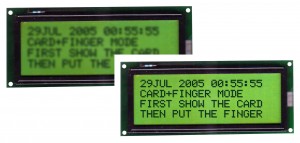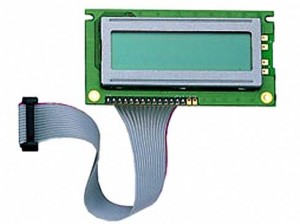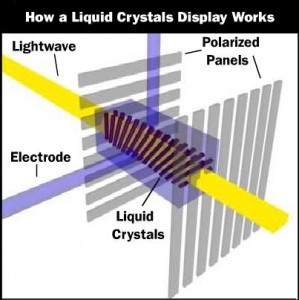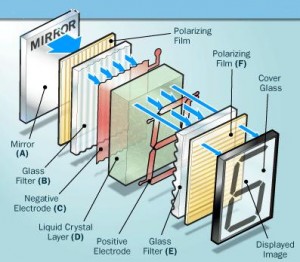LCD DISPLAY
Normal LCD doesn’t emit any light, an external light source is used to view. The iWatch Systems LCD has inbuilt light (illuminator) and it is very easy to use in dark or such places having low level of light intensity.
Just adjust the Trim Pot, and get outstanding performance in low light environmental condition.
Fig: Difference using a Trim Pot present on iWatch Access Control Panel.
LCDs are common because they offer some real advantages over other display technologies. They are thinner and lighter and draw much less power than cathode ray tubes (CRTs).
LCD is connected to the iWatch Access Control Panel with the help of a flat cable. It consists of 18 thin wires, well attached with each other in a single axis. At one end there are 18 male connectors which are supposed to connect with the back side of iWatch Access Control Panel, on the other end there are 18 female connectors which are used to connect with the male ports present on the LCD. The 1st number cable is red in colour as a polarity marking. Polarity should be considered while connecting LCD and iWatch Access Control Panel.
Fig: LCD connected with flat cable.
Principle of LCD: Solids act the way they do because their molecules always maintain their orientation and stay in the same position with respect to one another. The molecules in liquids are just the opposite: They can change their orientation and move anywhere in the liquid. But there are some substances that can exist in an odd state that is sort of like a liquid and sort of like a solid. When they are in this state, their molecules tend to maintain their orientation, like the molecules in a solid, but also move around to different positions, like the molecules in a liquid. This means that liquid crystals are neither a solid nor a liquid. One feature of liquid crystals is that they’re affected by electric current. A particular sort of nematic liquid crystal, called twisted nematics (TN), is naturally twisted. Applying an electric current to these liquid crystals will untwist them to varying degrees, depending on the current’s voltage. LCDs use these liquid crystals because they react predictably to electric current in such a way as to control light passage.
Most liquid crystal molecules are rod-shaped and are broadly categorized as either thermotropic or lyotropic.
Construction of LCD:
An LCD is a device that uses these four facts:
- Light can be polarized.
- Liquid crystals can transmit and change polarized light.
- The structure of liquid crystals can be changed by electric current.
- There are transparent substances that can conduct electricity.
Fig: How LCD work.
Two pieces of Polarized glass is present in the assembly. A special polymer that creates microscopic grooves in the surface is rubbed on the side of the glass that does not have the polarizing film on it. The grooves must be in the same direction as the polarizing film. After that add a coating of nematic liquid crystals to one of the filters. The grooves will cause the first layer of molecules to align with the filter’s orientation. Then add the second piece of glass with the polarizing film at a right angle to the first piece. Each successive layer of TN molecules will gradually twist until the uppermost layer is at a 90-degree angle to the bottom, matching the polarized glass filters.
As light strikes the first filter, it is polarized. The molecules in each layer then guide the light they receive to the next layer. As the light passes through the liquid crystal layers, the molecules also change the light’s plane of vibration to match their own angle. When the light reaches the far side of the liquid crystal substance, it vibrates at the same angle as the final layer of molecules. If the final layer is matched up with the second polarized glass filter, then the light will pass through.
If we apply an electric charge to liquid crystal molecules, they untwist. When they straighten out, they change the angle of the light passing through them so that it no longer matches the angle of the top polarizing filter. Consequently, no light can pass through that area of the LCD, which makes that area darker than the surrounding areas. And hence the darker area appears as the displayed character.











July 18th, 2010 at
My colleage was laughing at me when reading one paragraph on your blog “……” it makes me to look more knowledgable after learning it.
July 18th, 2010 at
Whenever you go through a lengthy article at first you feel bore but at the end you gain most out of it. Thanks for reading our blog.
September 9th, 2010 at
After much thought I believe your title “liquid crystal display in iwatch securitysystems, lcd technical…” font size doesn’t fully formed on my web browser, (I just want to let you know) but perhaps it’s my custom configured firefox plugin that is causing a problem otherwise this is a good topic.